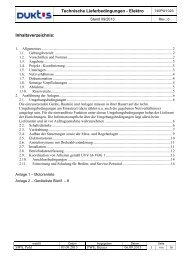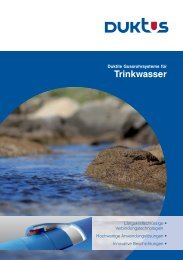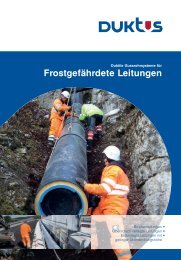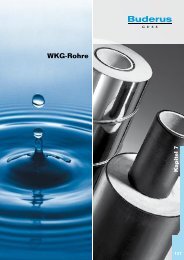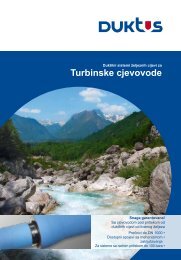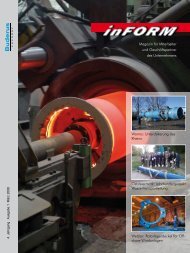Buderus Manual on Trenchless Installation of Ductile Cast ... - Duktus
Buderus Manual on Trenchless Installation of Ductile Cast ... - Duktus
Buderus Manual on Trenchless Installation of Ductile Cast ... - Duktus
You also want an ePaper? Increase the reach of your titles
YUMPU automatically turns print PDFs into web optimized ePapers that Google loves.
joints is DVGW Arbeitsblatt GW 3 8 <strong>of</strong><br />
June 2002 [2. ]. The current designs are<br />
shown in secti<strong>on</strong> in this document together<br />
with the associated performance data.<br />
A distincti<strong>on</strong> is made between joints which<br />
are locked by fricti<strong>on</strong> and joints which are<br />
positively locked. With its BRS ® fricti<strong>on</strong>locking<br />
joint and its BLS ® positive-locking<br />
joint, <str<strong>on</strong>g>Buderus</str<strong>on</strong>g> <strong>of</strong>fers two innovative soluti<strong>on</strong>s<br />
in this case. In the BRS ® fricti<strong>on</strong>locking<br />
joint (Fig. 2.17), sharp, hardened<br />
stainless steel teeth bite into the surface<br />
<strong>of</strong> the inserting end and this produces<br />
the fricti<strong>on</strong>al c<strong>on</strong>necti<strong>on</strong>. There are also<br />
fricti<strong>on</strong>-locking designs for bolted-gland<br />
socket joints.<br />
In the BLS ® positive-locking joint, a bead<br />
<strong>of</strong> weld metal is applied to the surface <strong>of</strong><br />
the inserting end either in the factory or<br />
<strong>on</strong> site and appropriate force-transmitting<br />
members are supported against this<br />
bead and thus transmit the l<strong>on</strong>gitudinal<br />
force from <strong>on</strong>e pipe to the next (Fig.2.18).<br />
Fig. 2.17<br />
Fig. 2.18<br />
Entwicklung der Verbindungstechnik<br />
The development <strong>of</strong> these socket joints, which are locked against l<strong>on</strong>gitudinal forces<br />
but at the same time able to hinge, to their present-day standard <strong>of</strong> maturity was essential<br />
to the development <strong>of</strong> modern-day trenchless techniques for installing pressure<br />
pipelines. In almost all <strong>of</strong> the trenchless installati<strong>on</strong> and renovati<strong>on</strong> techniques which<br />
are described in the present manual, it is a hinged string <strong>of</strong> pipes locked against l<strong>on</strong>gitudinal<br />
forces which is pulled into the final route <strong>of</strong> the pipeline. Whereas in the series<br />
<strong>of</strong> standards which applied previously, namely DIN 28 00 et seq., it was just the pipes<br />
and fittings which were exactly described, in the European standards which now apply,<br />
namely DIN EN for water pipes and DIN EN 9 for sewage c<strong>on</strong>duits and pipes,<br />
there is a new aspect which is c<strong>on</strong>sidered, namely the functi<strong>on</strong>al requirements they<br />
have to meet. With their exact descriptive specificati<strong>on</strong>s, the earlier nati<strong>on</strong>al standards<br />
provided what was needed for technical delivery c<strong>on</strong>diti<strong>on</strong>s. The additi<strong>on</strong>al aspect<br />
dealt with by the European standards, namely the functi<strong>on</strong>al requirements which the<br />
17



